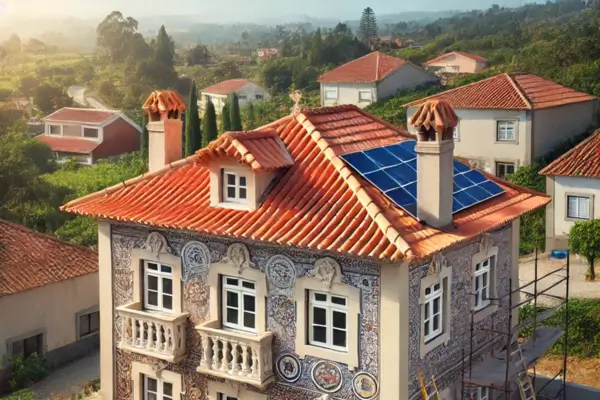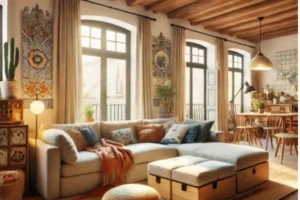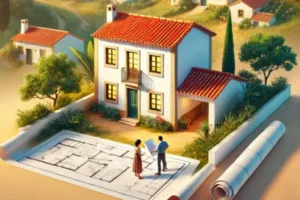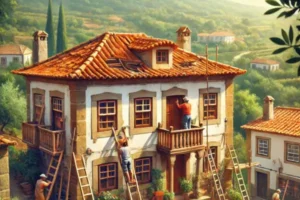Portugal is not just a destination; it’s a lifestyle—and the home you choose reflects this journey. For expatriate families looking to settle down, the type of house you select shapes more than just your daily routine—it becomes part of your family’s story. Whether you’re eyeing a quaint stone cottage or a sprawling villa, understanding the essence of Portuguese architecture can help you make a smarter investment.
Portuguese homes are as diverse as the landscapes they inhabit. From the sturdy, earthquake-resistant Pombaline buildings in Lisbon to the rustic, sun-soaked farmhouses of the Algarve, each style carries its own history and charm. For families on a budget, this variety offers an opportunity to find affordable gems—homes full of potential, waiting to be revitalized with modern comforts.
This guide is designed to help you navigate these architectural wonders while keeping practicality in mind. By understanding Portuguese building styles, you can strike the perfect balance between preserving tradition and creating a family-friendly space that feels like home. Let’s dive in and explore how to turn your dream of a Portuguese family home into reality.
A Snapshot of Portuguese Architecture
Portugal’s rich history is reflected in the incredible variety of architectural styles found across the country. For families planning a renovation, understanding these styles isn’t just about aesthetics—it’s about knowing what works for your needs. From ornate details to practical layouts, each style offers unique opportunities for creating a home that’s functional, affordable, and full of character. Here’s a closer look at some key architectural subtypes and how they can work for your family.
Manueline (Early Renaissance)
This iconic Portuguese style, sometimes called “the flamboyant Gothic,” flourished during the Age of Discovery. Expect elaborate stone carvings inspired by maritime themes—think ropes, anchors, and sea creatures—and grand arched doorways that invite you in with drama and elegance.
- Key Features: Decorative stonework, large windows, and intricate columns.
- Family-Friendly Potential: Many Manueline-era homes boast thick stone walls, which are excellent for insulation, keeping the house cool in summer and warm in winter. Their spacious layouts can be adapted to include open family areas or modern kitchens while preserving historic charm.
Pombaline (18th Century)
Developed after the devastating 1755 earthquake, Pombaline architecture prioritizes safety and functionality without sacrificing style. These homes, often found in Lisbon’s Baixa district, are characterized by their grid-like layouts and subtle elegance.
- Key Features: Symmetrical facades, large sash windows, and reinforced timber frames for earthquake resistance.
- Family-Friendly Potential: Pombaline buildings often come with multiple floors and compact designs, ideal for creating private spaces for each family member. Open-concept renovations work particularly well here, as the structures are designed to handle modifications without compromising stability.
Modernist Influences (20th Century)
By the mid-20th century, Portuguese architecture embraced simplicity, practicality, and innovation. Modernist homes prioritize clean lines, functional spaces, and an effortless connection to the outdoors.
- Key Features: Flat roofs, large glass windows, and minimalist interiors that maximize natural light.
- Family-Friendly Potential: These homes are naturally adaptable to modern family needs, with open-plan living spaces perfect for children. Renovations can focus on creating energy-efficient systems like solar panels or expanding outdoor areas for play and relaxation.
How These Styles Fit Family Living
Each architectural style has its own charm, but they all share an ability to adapt to family life with the right approach. Whether it’s opening up a Pombaline layout, restoring Manueline-era grandeur, or embracing the practicality of modernist design, these homes provide a solid foundation to create something uniquely yours.
By understanding the core elements of these styles, you’ll not only preserve their heritage but also unlock their potential for creating a comfortable and affordable family home in Portugal.
Assessing What Style Matches Your Needs
Choosing the right Portuguese home for your family is about more than just appearance—it’s about how well the structure, layout, and features meet your daily needs. By understanding the characteristics of traditional and modern Portuguese architecture, you can make an informed decision that balances practicality, comfort, and affordability.
Understanding Structural Characteristics
Thick Stone Walls
A hallmark of traditional Portuguese homes, thick stone walls provide excellent insulation, keeping interiors cool during scorching summers and warm in the winter. However, they can sometimes retain moisture, leading to dampness or mold if not properly maintained.
- Pros: Naturally energy-efficient, durable, and ideal for extreme weather conditions.
- Cons: Dampness can be an issue, particularly in coastal or humid regions. Solutions like improved ventilation and dehumidifiers can help.
Tile Roofs
Terracotta tile roofs are iconic in Portuguese architecture and offer both charm and function. They’re highly effective at shedding rain, which is critical in Portugal’s wetter northern regions, but they do require periodic upkeep to prevent leaks or cracks.
- Pros: Aesthetically pleasing, weather-resistant, and long-lasting when well-maintained.
- Cons: Maintenance costs can add up, especially for older homes. Regular inspections are key.
Space Considerations for Families
Narrow Layouts in Older Homes
Many traditional Portuguese homes feature narrow, compartmentalized layouts, reflecting older building styles that prioritized privacy and individual rooms. While these spaces can feel cozy and intimate, they might not suit families accustomed to open-plan living.
- Adapting to Family Needs: Walls can often be removed or reconfigured to create larger communal areas like a combined kitchen and living room. However, ensure structural integrity by consulting with a professional before making major changes.
Outdoor Spaces and Gardens
Portuguese homes often make the most of their outdoor spaces, whether it’s a small tiled courtyard, a sunny balcony, or a lush backyard. The type of outdoor area you’ll find depends heavily on the region and the style of the home.
- Northern Portugal: Homes often feature enclosed courtyards or gardens, providing safe spaces for children to play.
- Central & Southern Portugal: Expect larger patios or terraces, perfect for al fresco dining and family gatherings.
- What to Look For: Outdoor areas that offer both privacy and functionality, with enough room for your family’s needs—be it a garden for kids or a terrace for relaxing.
By assessing these structural and spatial elements, you’ll gain a clearer picture of what works for your family. Whether it’s reimagining a traditional stone home for modern comfort or embracing a contemporary design with seamless indoor-outdoor living, understanding these details will ensure your Portuguese home is as practical as it is beautiful.
Renovation Challenges and Opportunities
Renovating a home in Portugal can be an exciting way to blend history and modern living, especially for expatriate families looking to settle down. However, these projects often come with unique challenges that require thoughtful planning. From navigating regulations to upgrading utilities, understanding the hurdles—and opportunities—can help you create a comfortable and family-friendly space without losing the home’s authentic charm.
Common Renovation Hurdles
Preserving Historical Integrity
Many older Portuguese homes, particularly those in historic districts, are protected by regulations that restrict certain renovations to preserve their heritage. This can limit exterior changes, such as altering facades, windows, or roofs.
- The Challenge: Balancing family-friendly upgrades with respecting local laws and cultural significance.
- Solution: Work with architects and contractors experienced in navigating these regulations. They can help you find creative ways to modernize interiors while adhering to external restrictions.
Plumbing and Electrical Upgrades
Older homes often come with outdated plumbing and electrical systems that weren’t designed to handle modern appliances or high energy demands. This is a critical area for families, as reliable infrastructure is key to comfort and safety.
- The Challenge: Retrofitting these systems without extensive disruption to the home’s structure.
- Solution: Plan for these upgrades early in your budget, as they can be costly but essential. Opt for sustainable systems where possible, such as energy-efficient wiring or water-saving fixtures.
Tips for Blending Tradition and Modern Comforts
Keeping Traditional Azulejos
Azulejos, the iconic Portuguese ceramic tiles, are often found in kitchens, bathrooms, and even exterior walls. These decorative tiles add a unique and historical charm to any home.
- Opportunity: Retain these features as a focal point while updating surrounding areas for modern use.
- How to Do It: Complement azulejos with neutral tones or minimalist designs to let the tiles shine. For practical spaces like bathrooms, combine traditional tiles with modern fixtures for the best of both worlds.
Energy-Efficient Updates
Portugal’s sunny climate makes it ideal for incorporating sustainable energy solutions like solar panels, which are increasingly popular. Adding insulation to thick stone walls or installing double-glazed windows can also enhance energy efficiency without altering the home’s aesthetics.
- Opportunity: Lower long-term energy costs while making your home eco-friendly.
- How to Do It: Look for government grants or incentives for renewable energy upgrades, and prioritize these updates during renovation to maximize savings.
Renovating a Portuguese home is about finding harmony between old and new. While the challenges may feel daunting, they’re often outweighed by the opportunities to create a one-of-a-kind space that respects tradition while meeting your family’s needs. With the right approach, you’ll transform your home into a beautiful and functional retreat steeped in Portuguese heritage.
Navigating Portuguese Building Regulations
Renovating a home in Portugal, especially as an expatriate, requires navigating a landscape of local laws and regulations. Understanding the legal framework is essential to ensure your project runs smoothly and avoids costly setbacks. Whether you’re updating a historic property or modernizing a family home, getting familiar with the rules and finding the right professionals can make all the difference.
Permits and Permissions
Rules for Renovating Historical Properties
Many older homes, particularly those located in designated heritage areas, are protected under Portuguese law. These properties often require special permits for renovations to ensure that their historical and architectural integrity is preserved.
- What’s Restricted?: Exterior changes, such as altering facades, windows, or traditional features like tile roofs, often require approval from local councils.
- How to Proceed: Contact the municipal office (Câmara Municipal) early in your planning process to determine what’s allowed and gather the necessary paperwork.
What Expatriates Should Know About Local Laws
As a non-local, you might encounter additional hurdles, such as understanding region-specific regulations or language barriers. Building codes, zoning laws, and energy-efficiency requirements vary between municipalities, so what’s permissible in Lisbon may differ in the Algarve.
- Common Challenges: Misunderstanding what constitutes “major” vs. “minor” renovations.
- Key Tip: Work with a bilingual legal consultant or project manager familiar with Portuguese construction laws to avoid missteps.
Tips for a Smooth Process
Finding Reputable Contractors and Architects
Hiring professionals who are not only skilled but also experienced with local regulations and expat needs is essential for a stress-free renovation.
- What to Look For:
- Licensed professionals with strong portfolios of similar projects.
- Contractors who understand the nuances of renovating traditional Portuguese homes.
- Architects with experience blending modern functionality with historic aesthetics.
- How to Verify:
- Ask for references and check online reviews.
- Confirm their registration with Portuguese regulatory bodies like the Ordem dos Arquitectos (Architects’ Order).
Practical Steps for Success
- Get Everything in Writing: From initial estimates to contracts, ensure all terms and agreements are clearly documented in both Portuguese and your preferred language.
- Budget for Delays: Permits and inspections can take longer than expected, especially in historic areas. Build a buffer into your timeline to account for potential delays.
- Stay Involved: Regularly check in on the progress of your renovation to address any issues early and maintain alignment with local regulations.
By understanding Portuguese building regulations and assembling the right team, you can avoid common pitfalls and ensure your renovation is a success. With preparation, patience, and the right support, you’ll navigate these complexities and create a home that perfectly blends your family’s needs with Portugal’s architectural heritage.
Budgeting for Renovations
Renovating a home in Portugal can be an exciting journey, but it’s essential to approach it with a well-thought-out budget. Different architectural styles, materials, and regulatory requirements can significantly influence costs. By understanding common expenses and exploring ways to save, you can achieve a beautiful and functional family home without overspending.
Cost Considerations for Different Styles
Traditional Stonework vs. Modern Materials
Older Portuguese homes, particularly those with thick stone walls, often require specialized materials and labor for repairs. Restoring stonework or traditional tile roofs can be more expensive than using modern construction methods, but the results are often worth it for their durability and timeless aesthetic.
- Traditional Stonework Costs: Skilled stonemasons and authentic materials can drive up costs. Repairs to older structures may also reveal hidden issues, such as structural cracks.
- Modern Materials Costs: While typically cheaper, they may lack the character of traditional elements. However, modern materials can reduce costs in energy efficiency and maintenance.
Unexpected Costs
Renovating in Portugal often comes with surprises, particularly in older properties where the full scope of work isn’t clear until construction begins.
- Permits and Inspections: Fees for permits and mandatory inspections can vary based on the municipality and the scope of your project.
- Artisan Craftsmanship: Preserving features like azulejos (tiles) or wrought ironwork often requires hiring artisans, which can add a premium to your budget.
Tips for Saving While Preserving Charm
Reusing Materials
One of the best ways to save money while maintaining the character of your home is to repurpose existing materials.
- Tiles and Wood: Portuguese homes often feature stunning azulejos or high-quality hardwood floors that can be cleaned, restored, and reused.
- Stonework: Salvaging and reusing original stone for walls or landscaping can reduce material costs while preserving authenticity.
Leveraging Government Grants
Portugal offers incentives for sustainable renovations, which can help lower costs while making your home more eco-friendly.
- Energy Efficiency Grants: Programs are available for adding solar panels, upgrading insulation, or installing energy-efficient windows.
- How to Apply: Research eligibility requirements and application processes through local municipalities or government websites, or work with a contractor familiar with these programs.
By carefully planning your renovation budget and exploring cost-saving opportunities, you can preserve the charm of your Portuguese home while keeping expenses manageable. Whether it’s reusing materials, prioritizing energy-efficient upgrades, or investing in timeless craftsmanship, the key is to balance affordability with long-term value for your family.
Building a Home That Tells Your Family’s Story
Understanding Portuguese building styles is more than just a step in the renovation process—it’s a way to connect with the culture and history of your new home. By appreciating the unique charm of Manueline stonework, Pombaline practicality, or modernist simplicity, you can create a living space that respects tradition while meeting your family’s needs for comfort and functionality.
As an expatriate, embracing the cultural richness of your Portuguese home can be a rewarding experience. Every tile, archway, or garden tells a story, and with thoughtful renovations, you can add your own chapter to this legacy. Whether you’re restoring a historic gem or modernizing a rustic farmhouse, your home can become a blend of heritage and personal expression.
We’d love to hear about your journey! Share your renovation story, ask for advice, or connect with others navigating similar projects. Together, we can celebrate the beauty of Portuguese architecture and make your dream family home a reality.




